跨文化交际报告英文版
跨文化交际相关的英语作文

跨文化交际相关的英语作文Living in a multicultural society, we are constantly exposed to different customs, traditions, and ways of thinking. It can be both enriching and challenging to navigate through the complexities of cross-cultural communication.When interacting with people from different cultural backgrounds, it's important to be open-minded and respectful. We should strive to understand and appreciate their perspectives, even if they differ from our own.Language barriers can often pose a challenge in cross-cultural communication. It's important to be patient and understanding when trying to communicate with someone who speaks a different language. Using simple and clear language, along with gestures and visual aids, can help bridge the gap.Non-verbal communication, such as body language, facialexpressions, and gestures, varies across cultures. What may be considered polite in one culture could be seen as rudein another. It's important to be aware of these differences and adapt our non-verbal communication accordingly.Cultural norms and etiquette also play a significant role in cross-cultural communication. What may be acceptable behavior in one culture could be taboo in another. It's important to familiarize ourselves with the cultural norms of the people we are interacting with to avoid unintentionally causing offense.Misunderstandings are inevitable in cross-cultural communication, but it's important to address them with empathy and a willingness to learn. Instead of jumping to conclusions or making assumptions, we should seek clarification and strive to understand the root of the misunderstanding.In conclusion, cross-cultural communication requires an open mind, patience, and a willingness to learn and adapt. By being respectful, understanding, and empathetic, we cannavigate the complexities of multicultural interactions and foster meaningful connections with people from diverse backgrounds.。
商务英语跨文化交际实习报告
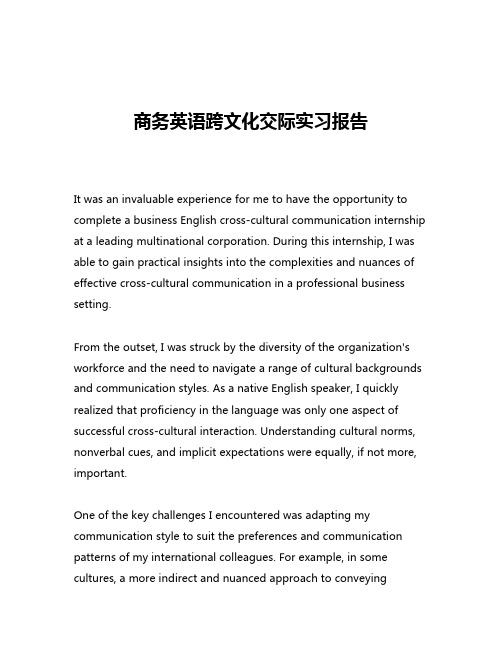
商务英语跨文化交际实习报告It was an invaluable experience for me to have the opportunity to complete a business English cross-cultural communication internship at a leading multinational corporation. During this internship, I was able to gain practical insights into the complexities and nuances of effective cross-cultural communication in a professional business setting.From the outset, I was struck by the diversity of the organization's workforce and the need to navigate a range of cultural backgrounds and communication styles. As a native English speaker, I quickly realized that proficiency in the language was only one aspect of successful cross-cultural interaction. Understanding cultural norms, nonverbal cues, and implicit expectations were equally, if not more, important.One of the key challenges I encountered was adapting my communication style to suit the preferences and communication patterns of my international colleagues. For example, in some cultures, a more indirect and nuanced approach to conveyinginformation is preferred, whereas in others, a more direct and assertive style is the norm. Learning to recognize these differences and adjust my approach accordingly was crucial in building rapport and facilitating productive discussions.Another important aspect of my internship was observing and participating in virtual meetings and video conferences involving team members from diverse geographical locations. This exposed me to the unique challenges of cross-cultural communication in a digital environment, where factors such as time zone differences, technological limitations, and cultural interpretations of body language and tone could significantly impact the effectiveness of the interaction.I found that successful virtual communication required a heightened level of intentionality and active listening. Ensuring that all participants felt heard and understood, despite potential language barriers or technological issues, was essential in maintaining engagement and achieving the desired outcomes.One particularly memorable experience was a negotiation exercise involving a hypothetical business deal between representatives from different countries. This simulation highlighted the importance of cultural awareness and sensitivity in the negotiation process. Factors such as decision-making styles, attitudes toward risk, andperceptions of time and deadlines all played a significant role in the outcome of the negotiations.Through this exercise, I learned the value of researching and understanding the cultural context of my counterparts, as well as the need to approach negotiations with an open and adaptable mindset. Recognizing and respecting cultural differences, while also finding common ground, was crucial in navigating the complexities of cross-cultural business negotiations.In addition to these practical experiences, the internship also provided me with opportunities to attend workshops and training sessions on cross-cultural communication strategies. These sessions delved into topics such as cultural dimensions, communication styles, and conflict resolution techniques. The insights gained from these sessions were invaluable in helping me develop a more nuanced understanding of the challenges and best practices in cross-cultural business interactions.One of the key takeaways from these workshops was the importance of developing cultural intelligence – the ability to adapt and function effectively in diverse cultural settings. This involves not only gaining knowledge about different cultures but also cultivating the skills and mindset necessary to navigate cross-cultural situations with empathy, flexibility, and cultural sensitivity.Throughout my internship, I was also able to observe and learn from seasoned professionals who had extensive experience in cross-cultural business communication. Watching them navigate complex situations, build rapport with international colleagues, and effectively resolve conflicts was incredibly insightful and helped me refine my own communication skills.Perhaps the most valuable aspect of this internship, however, was the opportunity to apply what I had learned in real-world scenarios. Whether it was drafting emails, participating in meetings, or collaborating on projects, I was able to put my cross-cultural communication skills into practice and receive immediate feedback from my supervisors and colleagues.This hands-on experience was crucial in helping me develop a deeper understanding of the nuances and complexities involved in cross-cultural business interactions. It also allowed me to identify areas for personal growth and improvement, and to develop strategies for continuously enhancing my cross-cultural communication competencies.In conclusion, this business English cross-cultural communication internship has been an invaluable experience that has significantly expanded my understanding and appreciation of the challenges andbest practices in this field. The lessons I have learned, both through practical experiences and theoretical training, will undoubtedly serve me well as I continue to navigate the increasingly globalized business landscape. I am grateful for the opportunity to have participated in this internship and am confident that the skills and insights I have gained will be instrumental in my future career endeavors.。
英语作文模板跨文化交际
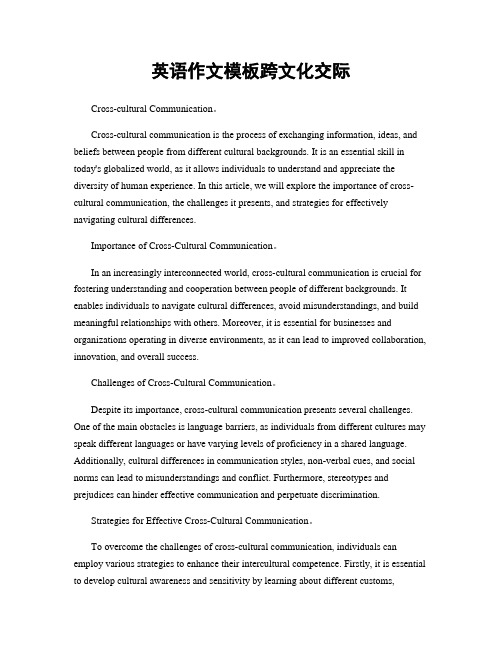
英语作文模板跨文化交际Cross-cultural Communication。
Cross-cultural communication is the process of exchanging information, ideas, and beliefs between people from different cultural backgrounds. It is an essential skill in today's globalized world, as it allows individuals to understand and appreciate the diversity of human experience. In this article, we will explore the importance of cross-cultural communication, the challenges it presents, and strategies for effectively navigating cultural differences.Importance of Cross-Cultural Communication。
In an increasingly interconnected world, cross-cultural communication is crucial for fostering understanding and cooperation between people of different backgrounds. It enables individuals to navigate cultural differences, avoid misunderstandings, and build meaningful relationships with others. Moreover, it is essential for businesses and organizations operating in diverse environments, as it can lead to improved collaboration, innovation, and overall success.Challenges of Cross-Cultural Communication。
跨文化交际英语作文
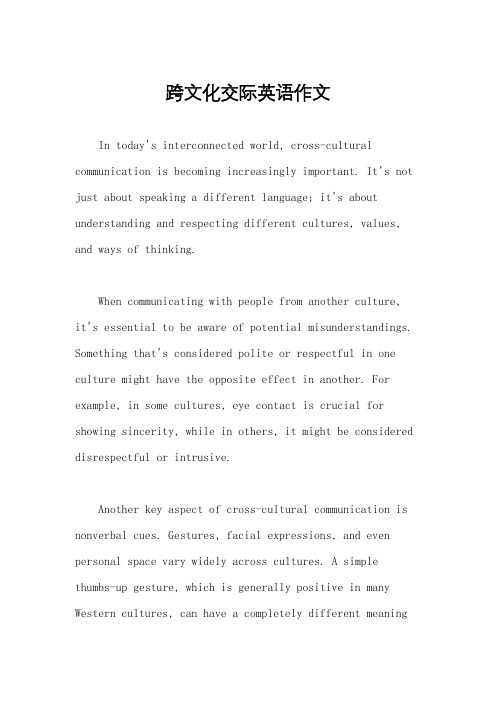
跨文化交际英语作文In today's interconnected world, cross-cultural communication is becoming increasingly important. It's not just about speaking a different language; it's about understanding and respecting different cultures, values, and ways of thinking.When communicating with people from another culture, it's essential to be aware of potential misunderstandings. Something that's considered polite or respectful in one culture might have the opposite effect in another. For example, in some cultures, eye contact is crucial for showing sincerity, while in others, it might be considered disrespectful or intrusive.Another key aspect of cross-cultural communication is nonverbal cues. Gestures, facial expressions, and even personal space vary widely across cultures. A simple thumbs-up gesture, which is generally positive in many Western cultures, can have a completely different meaningin other parts of the world.Adapting to these differences can be challenging, but it's also a rewarding experience. Learning about different cultures broadens our horizons and makes us more understanding and tolerant of others. It can also open up new opportunities for personal and professional growth.Of course, there's no one-size-fits-all approach to cross-cultural communication. Each situation and each individual is unique. The best approach is to be open-minded, curious, and willing to learn. By doing so, we can bridge cultural divides。
跨文化交际英语写作范文
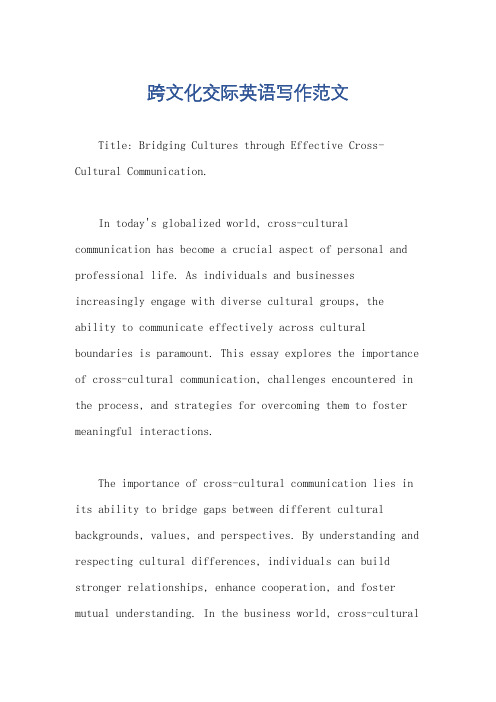
跨文化交际英语写作范文Title: Bridging Cultures through Effective Cross-Cultural Communication.In today's globalized world, cross-cultural communication has become a crucial aspect of personal and professional life. As individuals and businesses increasingly engage with diverse cultural groups, theability to communicate effectively across cultural boundaries is paramount. This essay explores the importance of cross-cultural communication, challenges encountered in the process, and strategies for overcoming them to foster meaningful interactions.The importance of cross-cultural communication lies in its ability to bridge gaps between different cultural backgrounds, values, and perspectives. By understanding and respecting cultural differences, individuals can build stronger relationships, enhance cooperation, and foster mutual understanding. In the business world, cross-culturalcommunication skills are essential for international negotiations, marketing strategies, and managing diverse teams. Successful cross-cultural communication can lead to increased profits, improved brand reputation, and greater market penetration.However, cross-cultural communication is not without its challenges. Language barriers, differences in communication styles, and misinterpretations of cultural cues can lead to misunderstandings and conflicts. Cultural stereotypes and biases can also hinder effective communication, leading to misunderstandings and misperceptions. Additionally, differences in social norms and etiquette can cause confusion and embarrassment.To overcome these challenges and foster effective cross-cultural communication, individuals must adopt a culturally sensitive approach. The first step is to gain awareness of one's own cultural values and biases. By understanding our own cultural lens, we can better appreciate and adapt to different cultural perspectives. Active listening and.。
跨文化交际介绍英语作文

跨文化交际介绍英语作文Title: Cross-Cultural Communication: Bridging the Divide。
In our increasingly interconnected world, cross-cultural communication skills have become more crucial than ever before. Whether it's for business, travel, or simply building relationships, the ability to effectively communicate across cultures can open doors and foster understanding. In this essay, we will explore the importance of cross-cultural communication and provide practical tips for navigating cultural differences.First and foremost, understanding cultural differences is key to successful cross-cultural communication. Cultures vary in their communication styles, norms, values, and perceptions. What may be considered polite or appropriatein one culture may be completely different in another. For example, while direct communication is valued in Western cultures, it may be perceived as rude or confrontational insome Asian cultures where indirect communication is preferred.To navigate these differences effectively, it's essential to approach interactions with an open mind and a willingness to learn. Avoid making assumptions or judgments based on your own cultural perspective. Instead, take the time to observe and listen to how people communicate within a particular cultural context. Pay attention to non-verbal cues such as body language, gestures, and facial expressions, as these can convey important messages that may not be explicitly stated.Another important aspect of cross-cultural communication is language proficiency. While English has become a global lingua franca, it's important to remember that not everyone speaks English fluently. In fact, many people may feel more comfortable communicating in their native language. Therefore, it's helpful to learn some basic phrases in the language of the culture you're interacting with as a sign of respect and effort to bridge the language gap.Furthermore, cultural sensitivity and empathy are essential components of effective cross-cultural communication. Put yourself in the shoes of someone from a different cultural background and try to understand their perspective. Be mindful of cultural taboos, customs, and traditions, and avoid inadvertently causing offense. For example, certain topics such as politics, religion, and personal beliefs may be sensitive subjects in some cultures and should be approached with caution.In addition to interpersonal communication, technology has also played a significant role in facilitating cross-cultural interactions. Platforms such as social media, video conferencing, and messaging apps allow people from different parts of the world to connect and communicate instantaneously. However, it's important to be aware of cultural differences in the use of technology and to adapt your communication style accordingly.In conclusion, cross-cultural communication isessential for navigating our diverse and interconnectedworld. By understanding and respecting cultural differences, improving language proficiency, and practicing empathy and sensitivity, we can bridge the divide and build meaningful connections across cultures. As we continue to engage with people from different backgrounds, let us embrace the richness of cultural diversity and celebrate theopportunity to learn from one another.。
跨文化交际 英文作文
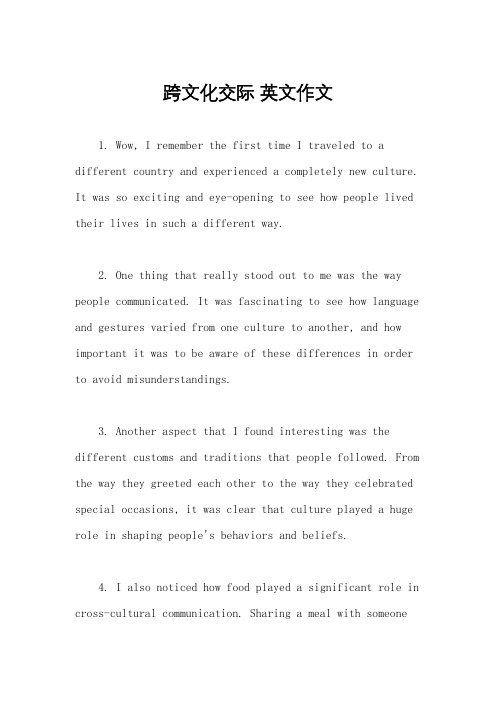
跨文化交际英文作文1. Wow, I remember the first time I traveled to a different country and experienced a completely new culture. It was so exciting and eye-opening to see how people lived their lives in such a different way.2. One thing that really stood out to me was the way people communicated. It was fascinating to see how language and gestures varied from one culture to another, and how important it was to be aware of these differences in order to avoid misunderstandings.3. Another aspect that I found interesting was the different customs and traditions that people followed. From the way they greeted each other to the way they celebrated special occasions, it was clear that culture played a huge role in shaping people's behaviors and beliefs.4. I also noticed how food played a significant role in cross-cultural communication. Sharing a meal with someonefrom a different culture was a great way to connect and learn more about their background and values.5. Overall, my experiences with cross-cultural communication have taught me to be more open-minded and respectful of others' differences. It's important to approach new cultures with curiosity and a willingness to learn, rather than judgment or preconceived notions.。
跨文化交际英文期末总结

跨文化交际英文期末总结Introduction:Cross-cultural communication refers to the process of exchanging information, ideas, and beliefs between individuals from different cultural backgrounds. With globalization becoming a dominant force, cross-cultural communication has gained utmost significance in various spheres of life, including business, education, and diplomacy. This comprehensive summary aims to provide an overview of key concepts, challenges, and strategies for effective cross-cultural communication.I. Key Concepts:1. Culture:Culture encompasses the shared beliefs, values, norms, customs, behaviors, and artifacts of a specific group of people. It influences communication styles, attitudes towards time, decision-making approaches, and perceptions of verbal and non-verbal cues.2. Cultural Sensitivity:Cultural sensitivity entails being aware of, acknowledging, and respecting the cultural diversities one encounters. It recognizes that people from different cultures have varying communication styles, perspectives, and expectations.3. Ethnocentrism:Ethnocentrism refers to the belief that one's own culture is superior to others. It often leads to misunderstandings and conflicts in cross-cultural communication, hindering effective interaction.4. Stereotypes:Stereotypes are oversimplified, generalized perceptions or beliefs about a particular group of people based on their cultural background. Stereotypes are harmful as they lead to biases and discrimination, making effective communication difficult.II. Challenges in Cross-cultural Communication:1. Language Barriers:Language differences create a significant hurdle in effective cross-cultural communication. Misinterpretations, misunderstandings, and miscommunications frequently occur due to language proficiency gaps.2. Non-verbal and Cultural Differences:Non-verbal communication cues, such as body language, facial expressions, and gestures, can be interpreted differently in diverse cultures. This can lead to unintended messages and misunderstandings.3. Different Communication Styles:Different cultures have distinct communication styles, varying in directness, formality, and expression of emotions. Understanding and adapting to these diverse styles is crucial for effective cross-cultural communication.4. High-context vs. Low-context Cultures:Cultures can be categorized as high-context or low-context based on their emphasis on direct vs. indirect communication. High-context cultures rely on shared knowledge, non-verbal cues, and contextual understanding, while low-context cultures emphasize explicit, direct communication.III. Strategies for Effective Cross-cultural Communication:1. Cultural Awareness:Developing cultural awareness involves learning about different cultural norms, customs, and values. It enables individuals to understand and empathize with individuals from other cultures, improving communication effectiveness.2. Active Listening:Active listening involves giving one's full attention to the speaker, understanding both verbal and non-verbal cues, and asking clarifying questions. This practice enhances understanding and helps in avoiding misinterpretations.3. Adapting Communication Styles:Adapting one's communication style to match the expectations of the other culture is crucial for effective cross-cultural communication. Flexibility in tone, use of language, and non-verbal cues can reduce misunderstandings and build more meaningful connections.4. Avoiding Stereotypes:Consciously avoiding stereotypes and preconceived notions about other cultures promotes unbiased communication. Treating each individual as unique and understanding their perspective enhances cross-cultural understanding.5. Building Relationships:Investing time in building interpersonal relationships with individuals from diverse cultural backgrounds fosters trust, mutual respect, and appreciation. Understanding the values, interests, and concerns of others facilitates smoother communication.Conclusion:Cross-cultural communication plays a pivotal role in today's interconnected world. The key to effective cross-cultural communication lies in cultural sensitivity, awareness, and the ability to adapt communication styles. Overcoming language barriers, understanding non-verbal cues, and avoiding stereotypes are essential skills for successful cross-cultural communication. By embracing diversity and striving for mutual understanding, individuals and societies can bridge the cultural divide and foster harmonious relationships on a global scale.。
- 1、下载文档前请自行甄别文档内容的完整性,平台不提供额外的编辑、内容补充、找答案等附加服务。
- 2、"仅部分预览"的文档,不可在线预览部分如存在完整性等问题,可反馈申请退款(可完整预览的文档不适用该条件!)。
- 3、如文档侵犯您的权益,请联系客服反馈,我们会尽快为您处理(人工客服工作时间:9:00-18:30)。
Report of Culture Interview
We have done the interview on April 24, 2014 with Sophie from America. Culture is everywhere. It is a topic that we will never avoid. Maybe the concept of culture is abroad. But when divided into parts, it is simple for us to understand. Following I will e xplain my topic “Non-verbal Communication” and “Global Marketing”
First, “Non-verbal Communication” While referred to non-verbal communication, we may strike to gestures, another word, body language. It means that we speak with our vocal organs we converse with our whole bodies. You may have seen some gestures, such as “victory” “happy” “sad”… Here I want to explain some gestures that I have learned from my foreign teacher who is from America. For example, put your middle finger on your index finger, which means “good luck”. Clapping with someone when you win a game or others, which means “well done”. Tapping your fist with others, which means “good friends”. Using your middle finger and index finger like a scissor before your eyes, which means “I see you”. Isn‟t it interesting?
Sometimes the same gestures means different in different countries. If we can‟t know othercountries …culture. We may cause confusion in business. More seriously, we might lose important clients. I would suggest some strategies of dealing with non-verbal communication in business. First, do good homework on non-verbal before making business with people from different cultures. Better preparation would be reward with more agreeable interaction. Second, don‟t take everything neither for g ranted nor too seriously. Third, focus on the partner‟s behaviors and response so as to adjust one‟s own behavior. Forth, ask for explanation or get a chance to explain. Second, “Global Marketing” Globalization has been an unavoided tendency. Through this we can touch something we haven‟t ever seen in our country. Such as McDonald, KFC, Pepsi Cola, which have rolled up like a mat in China. Just McDonald, it is set up in 1950s, in 1987 entered China. It is obvious that it has been thriving over the past years. Before entering China, it has done full homework about Chinese lifestyle, eating habits, custom… in a word, culture. You can see the appearance of its special shops; they are respectively different in different countries. In China its main colors
are red and yellow, which fit Chinese tradition. And the slogan is also different. In China, “I‟m lovein it”, which reveals that Chinese love family. Moreover, their special foods are almost different. Also in America, they mainly target low-salary people, but in China they aim to young people. All of these differences depend on culture shock. What is more important is localization. Localization means attach the local features to its own specialties. Just like McDonald, as it combines the local features with its own specialties, it has succeeded in world. Only brand features fit the native custom, the industry can operate well. Otherwise, it will exit the predicted market even lose it. As you know globalization strategies has transferred from 4Ps to 4Cs. A good brand strategy must concentrate on customer even potential market.
Enclosure: 1. Picture with Sophie
2. Interview Questions
Appendix 1 picture with Sophie
Appendix 2 Interview Questions
1.In a business meeting, when introducing, is hosting side first or visiting side first
in America?
2.What will you do when good friends drop on you without any appointments?
3.Would you like to show us some gestures, such as victory, happy, sad….
4.Have you felt uncomfortable since you come to China?
5.How did you overcome bad feelings?
6.Do the women have the same status with man or do they take important positions
in America?
7.Could you explain differences between men and women in social works?
8.Did you experience negotiations with others?
9.What do you think about globalization on business?
10.Have you found some similarities between Chinese and American?
11.Are there any things out of your expectations in China?
12.What do you like best in China?。
